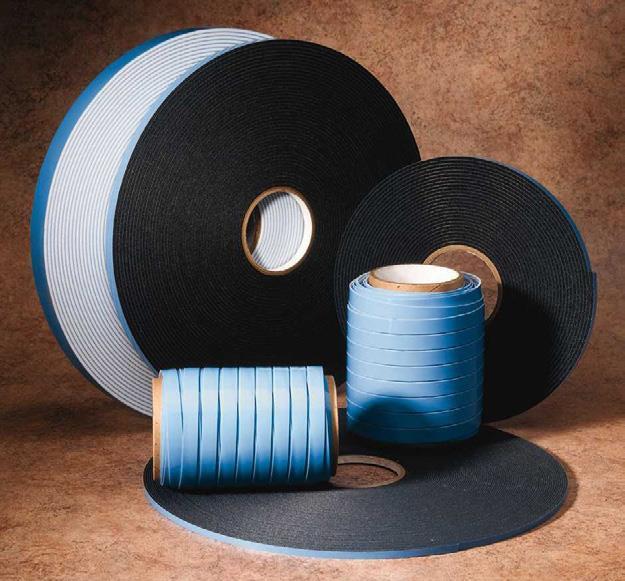When comparing Toptape’s two popular offerings—silicone tape and glazing tape—it is essential to examine their application areas to understand their similarities and differences. This exploration will highlight their respective advantages and help potential customers choose the best solution for their specific needs. While both tapes share some common characteristics, such as sealing and insulation capabilities, their unique properties make them suitable for different industries and purposes.
Table of Contents
Similar Application Areas of Glazing tape vs Silicone
Sealing and Insulation
Both silicone tape and glazing tape are widely used for sealing and insulation purposes. They are highly effective at creating airtight seals, preventing the passage of moisture, heat, and sound. This makes them indispensable in both residential and commercial settings, where these qualities are essential for improving energy efficiency and maintaining indoor comfort. Whether you’re sealing gaps around windows or providing insulation for various components, both tapes offer reliable performance in preventing air and moisture infiltration.
Construction Industry
Both types of tape play crucial roles in the construction industry, particularly in window installation and repair. Glazing tape, as its name suggests, is primarily designed for sealing windows, especially in double-glazing applications. Similarly, silicone tape is also used in construction, but its versatility extends to a wide range of sealing tasks beyond just windows. For example, it can be employed in sealing joints, repairing pipes, and insulating electrical connections in construction projects. In both cases, these tapes help enhance the energy efficiency of buildings, reduce noise pollution, and protect against weather elements.
Distinct Application Areas of Glazing tape vs Silicone
While silicone tape and glazing tape have overlapping applications, their primary uses differ significantly, making them suitable for different industries and scenarios.

Glazing Tape
Glazing tape is primarily used in the installation of window glass. It is an essential component in the construction and repair of windows, especially in modern buildings where double-glazing is common. Here are some specific application areas where glazing tape is highly effective:
Sealing Double-Glazing: One of the primary uses of glazing tape is in double-glazing applications. It is used to create a tight seal between the two glass panes and the window frame, preventing moisture and air from infiltrating the space between the panes.
Residential and Commercial Buildings: Glazing tape is widely used in both residential and commercial buildings for window installations. It is particularly effective in improving energy efficiency by minimizing heat loss and reducing drafts, which enhances indoor comfort.
Preventing Moisture and Air Infiltration: Glazing tape is specifically designed to seal the gap between the glass and the window frame. This is crucial in preventing the infiltration of moisture, which can lead to fogging or condensation between panes, and air leaks, which can affect the building’s thermal efficiency
Silicone Tape
Silicone tape, on the other hand, has a much broader range of applications that extend beyond window installation. It is known for its versatility and durability, making it suitable for use in various industries, from automotive to food processing. Some of the most common uses of silicone tape include:
Pipeline Repair and Electrical Insulation: Silicone tape is widely used for sealing and repairing pipelines, especially in high-temperature environments. Its self-fusing properties make it ideal for creating watertight seals, while its electrical insulation capabilities are essential for protecting electrical connections and preventing short circuits.
Automotive Maintenance: In the automotive industry, silicone tape is often used to repair hoses, wrap wiring harnesses, and insulate components exposed to heat and vibration. Its resistance to extreme temperatures and environmental factors makes it ideal for such applications.
Food Processing and Medical Uses: Silicone tape can be manufactured in food-grade varieties, making it suitable for use in the food industry. It is used in food processing facilities to seal equipment or piping that comes into contact with food. Additionally, silicone tape is also employed in medical settings for tasks such as securing bandages, insulating medical devices, or even in surgical applications due to its biocompatibility.
Similar or Different Applications of Glazing tape vs Silicone
Understanding why these tapes share some applications and differ in others requires a closer look at their physical properties.

Similarities
The primary reason silicone tape and glazing tape are both used in the construction industry is their waterproof and sealing capabilities. Both tapes excel at creating durable seals that prevent moisture and air from passing through, making them essential for insulation purposes. This shared characteristic explains their overlap in applications like window installation, where moisture control is critical for both energy efficiency and protecting the integrity of the building.
Differences
The differences in application arise from the specialized properties of each tape. Silicone tape’s ability to withstand extreme temperatures makes it ideal for use in environments such as ovens, steam pipes, and other high-heat situations. Furthermore, silicone tape can be manufactured in food-grade varieties, which opens up a whole range of applications in the food industry that glazing tape cannot cover.
On the other hand, glazing tape is specifically engineered for use with glass and window frames, making it the superior choice for tasks involving window installation and repair. Its focus on providing a weatherproof seal between glass and frame sets it apart from silicone tape, which is more of a general-purpose sealing solution.
Respective Advantages of Glazing tape vs Silicone
Both silicone tape and glazing tape offer distinct advantages that make them stand out in their respective applications.
Advantages of Glazing Tape
Optimized for Window Installation: Glazing tape is specially designed for sealing window glass, ensuring a long-lasting, watertight seal that prevents air and moisture infiltration.
Compatibility with Various Frame Materials: Whether the window frame is made of wood, metal, or PVC, glazing tape adheres well to these materials, making it a versatile option for various types of window installations.
Weatherability: Glazing tape is highly resistant to the elements, ensuring it holds up well in outdoor applications where it will be exposed to rain, snow, and fluctuating temperatures.

Advantages of Silicone Tape
Versatility: Silicone tape’s biggest advantage is its wide range of applications. It can be used in everything from household repairs to industrial installations, making it a multi-purpose product.
High-Temperature Resistance: Silicone tape can withstand extreme temperatures, making it indispensable in environments like automotive repair, oven sealing, and pipeline insulation where other tapes might fail.
Food-Grade Properties: In the food processing industry, silicone tape’s ability to meet food-grade standards ensures it can be safely used in environments that require strict hygiene and safety regulations.
When deciding between Toptape’s silicone tape and glazing tape, the choice depends on the specific application requirements and environmental conditions. For projects focused on window installation and sealing, glazing tape is the optimal choice due to its specialized design for glass-to-frame sealing. However, if you need a more versatile tape that can handle high temperatures, electrical insulation, or even food-grade applications, silicone tape offers unmatched flexibility. Both tapes provide reliable, high-quality solutions, ensuring that no matter the project, Toptape has the right product to meet your needs.





